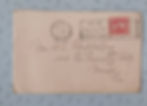Postmarks & Killers.
- Flea Market Love Letters
- Apr 25, 2021
- 3 min read
Today I'm talking about interesting "Postmarks" and "Killers" from the 1920s, 1930s, and 1940s. In nearly four years of archiving for Flea Market Love Letters I've come across some interesting envelopes. Often times an envelope can tell you almost as much as the letter inside. But what are "Postmarks" and "Killers"?
A Postmark is an imprint of black ink on the address side of a stamped "mail-piece". Indicates the location and date of when the Postal service accepted the mail-piece. A Killer is the name for the black lines which often run through a stamp, indicating that the stamp is monetarily worthless. Also known as a "cancellation stamp".
1920s:
Besides the very cool "New York N.Y. Grand Central Sta." postmark of this October 1920 letter are the: sideways stamp and "JOIN THE NAVY TRAINING - TRAVEL" killer. The sideways stamp could indicate a secret code between writer and recipient, but we could never know. It was only in 1974 that self-adhesive stamps were made available to letter writers. This letter comes from 1920 nearly two full years after the armistice of World War I. It is interesting that they were still employing Navy recruitment cancellation stamps.

The "Zoning Improvement Code" -- or "zip code" as it is known in the United States only came into circulation in 1963. In 1922 this "ADDRESS YOUR MAIL TO STREET AND NUMBER" cancellation stamp would have served as a reminder. It was after all only in 1918 that the AirMail network was established, which you can read about in our blog here.

Here again we have an upside down stamp...intentional or accidental? Who knows!
1930s:
It is interesting to note that in the tail-end of what would be known as "The Great Depression", this 1938 letter is marked with the cancellation stamp: "REGISTER OR INSURE VALUABLE MAIL". It speaks volumes for what was on the mind of hundreds of thousands of desperate Americans.

1940s:
This envelope is saying a lot already, just from a first glance. A patriotic envelope like this likely benefited the "War Effort", or at least the morale of the World War II soldier who received it. Stationery kits were available with illustrations and slogans of the moment like this striking Bald Eagle emblazoned with the "Call to Action" (CTA) of "AMERICA NEEDS YOUR HELP". This letter was written by a family member to the Private in Basic Training in California at the time. Posted from Trenton, New Jersey this envelope is emblazoned with a stoic Eagle and a cancellation stamp CTA to "GIVE RED CROSS WAR FUND". War Bonds, or funds, were a huge source of support for the War Effort in World War II.

Whereas in the above letter the U.S. was just two years into what would be called "World War II" in this later envelope we are less than six months away from the ceasefire. This time our letter has been sent from a soldier to his wife. The New York address does not reflect where the writer was stationed; often times mail for serving military members was sent to a location and parceled out to the front. But that it is not always the case.

This letter tells us that it was approved by a Naval Censor by the stamp in the lower left corner, and that it arrived to its recipient "via Air Mail". The Postmark is not a city or location like earlier, but simply "NAVY". While not the most interesting of envelopes it can tell us a decent amount about the time period in which it was sent. Secrecy was fundamental in the War Effort.
So far the letters we've looked at are all from the United States. This English post-war (1946) letter made the cut for today's blog by the cancellation stamp alone: "DON'T WASTE BREAD OTHERS NEED IT". While the war had been "over" for over six months by May 1946 the English people were still suffering from severe rationing. It would be years before life returned to a recognizable" normal for the English.
Notice that striking blue stamp? It's Queen Elizabeth's Father, King George IV. (Yes, the same King as in "The King's Speech"!). King George would die in 1952 and Elizabeth would become Queen. However in 1946 she was a twenty year old girl not even yet engaged to her future husband of 70+ years, Prince Philip. They would marry in 1947.

This letter makes the cut for today's review as a replica was recently spotted in our watch of the movie "The Guernsey Literary and Potato Peel Society" with the wonderful Handwritten Letter Appreciation Society earlier this month. The main character, Juliet, receives an envelope much like this one which begins her adventure in Guernsey so it felt appropriate to close our thoughts today on this note!

Get in Touch.
Something here strike your interest? Have a letter story you'd like to share? Write to us at info@fleamarketloveletters.com today!